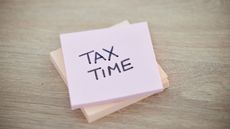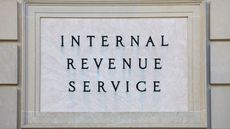Home Office Tax Deduction: Work-from-Home Write-Offs for 2022
Being able to claim the home office tax deduction if you are working from home, depends on your employment status.
- (opens in new tab)
- (opens in new tab)
- (opens in new tab)
- Newsletter sign up Newsletter


Like millions of other Americans, you may be working from home. (Data show that the number of people working from home nearly tripled over the past couple of years). And while there are some financial advantages to working from home, like saving money on commuting costs, work clothes and lunches, there can be other unreimbursed expenses. For example you're probably paying for printer paper and ink, and other office supplies. Plus, your electric and other utility bills are likely higher since you are at home all day. All of that may make you wonder whether you can claim a home office tax deduction for your expenses on your federal income tax return. Read on for some answers.
Home Office Tax Deduction: Who Qualifies?
Some people who work from home can deduct their business-related expenses and there is also something called the "home office tax deduction" that lets you write off expenses for the business use of your home. Whether or not you can claim those tax breaks, however, depends on your employment status.
Employees Miss Out. If you're a regular employee working from home, you can't deduct any of your related expenses on your tax return.

Sign up for Kiplinger’s Free E-Newsletters
Profit and prosper with the best of expert advice on investing, taxes, retirement, personal finance and more - straight to your e-mail.
Profit and prosper with the best of expert advice - straight to your e-mail.
Before 2018, you could claim an itemized deduction for unreimbursed business expenses, including expenses for the business use of part of your home if they exceeded 2% of your adjusted gross income. However, that deduction was temporarily suspended by the 2017 Tax Cuts and Jobs Act. It's scheduled to go back into effect in 2026, but we will have to wait and see if that happens.
Home Office Tax Deduction for Self-Employed People
Self-employed people can generally deduct office expenses on Schedule C (Form 1040) (opens in new tab) whether they work from home or not. This write-off covers office supplies, postage, computers, printers, and all the other ordinary and necessary things that you need to run a home office.
And if you're self-employed, the home office tax deduction may also be available — if you can satisfy all the requirements.
The home office tax deduction covers expenses for the business use of your home, including mortgage interest, rent, insurance, utilities, repairs, and depreciation. It doesn't matter what type of home you have, (e.g., single family, townhouse, apartment, condo, mobile home, or boat.) You can also claim the home office tax deduction if you worked in an outbuilding on your property, such as an unattached garage, studio, barn, or greenhouse.
But you cannot claim the home office tax deduction for any part of your home or property used exclusively as a hotel, motel, inn, or the like.
The key to the home office deduction is to use part of your home "regularly and exclusively" as your principal place of business. If you only work from home for part of the year, you can only claim the deduction for the period that you can satisfy the "regularly and exclusively" requirements.
"Regular use" means you use a specific area of your home (e.g., a room or other separately identifiable space) for business on a regular basis. Incidental or occasional use of the space for business doesn't count.
"Exclusive use" means you use a specific area of your home only for your trade or business. The space doesn't have to be marked off by a permanent partition. You can't claim the home office deduction if you use the space for both business and personal purposes. However, the exclusive use requirement might not apply if you use part of your home:
- For the storage of inventory or product samples; or
- As a daycare facility.
The space must also be used:
- As your principal place of business for your trade or business;
- To meet or deal with your patients, clients, or customers in the normal course of your trade or business; or
- In connection with your trade or business if it's a separate structure that's not attached to your home.
(See IRS Publication 587 (opens in new tab) for more information about these and other requirements for the home office deduction.)
How to Calculate the Home Office Deduction
If you qualify, there are two ways to calculate the home office deduction. Under the "actual expense" method, you essentially multiply the expenses of operating your home by the percentage of your home devoted to business use. If you work from home for part of the year, only include expenses incurred during that time.
Under the "simplified" method, you deduct $5 for every square foot of space in your home used for a qualified business purpose. Again, you can only claim the deduction for the time you work from home.
For example, if you have a 300-square-foot home office (the maximum size allowed for this method), and you work from home for three months (25% of the year), your deduction is $375 ((300 x $5) x 0.25).
Tax Tip: If you use the simplified method, you can't depreciate the part of your home used for business. However, to the extent you qualify, you can still claim itemized deductions for mortgage interest, real property taxes, and casualty losses for your home without allocating them between personal and business use.
The deduction is claimed on Line 30 of Schedule C (Form 1040) (opens in new tab). If you use your home for more than one business, file a separate Schedule C for each business. Don't combine your deductions for each business on a single Schedule C.
If you use the actual expense method to calculate the tax break, also complete Form 8829 (opens in new tab) and file it with the rest of your tax return. If you use more than one home for business, you can file a Form 8829 for each home or use the simplified method for one home and Form 8829 others. Combine all amounts calculated using the simplified method and amounts calculated using Form 8829, and then enter the total on Line 30 of the Schedule C you file for the business.
Employees with a Side Gig
If you're an employee at a "regular" job, but you also have your own side hustle, you can claim deductions for business expenses and the home office deduction for your own business — if you meet all the requirements. Being an employee doesn't mean you can't also claim the deductions you're entitled to as a self-employed person.
Rocky Mengle was a Senior Tax Editor for Kiplinger from October 2018 to January 2023 with more than 20 years of experience covering federal and state tax developments. Before coming to Kiplinger, Rocky worked for Wolters Kluwer Tax & Accounting, and Kleinrock Publishing, where he provided breaking news and guidance for CPAs, tax attorneys, and other tax professionals. He has also been quoted as an expert by USA Today, Forbes, U.S. News & World Report, Reuters, Accounting Today, and other media outlets. Rocky holds a law degree from the University of Connecticut and a B.A. in History from Salisbury University.
-
-
 Is Inflation a Big Retirement Worry? How to Protect Savings
Is Inflation a Big Retirement Worry? How to Protect SavingsConcerns about how inflation eats into your resources or limits your ability to save sufficiently for retirement are real, but there are four things you can do to cope.
By Jason “JB” Beckett • Published
-
 Short-Term Financial Planning for First-Time Parents
Short-Term Financial Planning for First-Time ParentsA seasoned wealth adviser shares his experience with the financial planning he and his wife did for the arrival of their first bundle of joy.
By Kara Duckworth, CFP®, CDFA® • Published
-
 How to Lower Your Tax Bill Next Year
How to Lower Your Tax Bill Next YearKnowing how to lower your tax bill (pay less taxes) when it's time to file your return next year requires some strategizing through the rest of 2023. Here are some tax tips to help make it happen.
By Katelyn Washington • Published
-
 Indiana Storm Victims Have an Extended IRS Tax Deadline
Indiana Storm Victims Have an Extended IRS Tax DeadlineIndiana taxpayers impacted by recent severe storms have an extension of the April 18 deadline to file federal tax returns.
By Katelyn Washington • Published
-
 IRS Says File Soon for $1.5 Billion in Unclaimed Tax Refunds
IRS Says File Soon for $1.5 Billion in Unclaimed Tax RefundsUnclaimed tax refunds from 2019 are waiting for millions of people who might not know it – but only if they file the pandemic-era tax return soon. Are you one of them?
By Kelley R. Taylor • Published
-
 Tax Tips for Last-Minute Filers
Tax Tips for Last-Minute FilersTime has run out for most people to file taxes for 2022, but these tax tips could help you file soon after the tax deadline and possibly keep more money in your pocket at the same time.
By Katelyn Washington • Published
-
 How to Pay the IRS if You Owe Taxes
How to Pay the IRS if You Owe TaxesThere are several ways to pay the IRS if you owe taxes, but just because you can pay your tax bill over time doesn’t always mean you should.
By Katelyn Washington • Published
-
 Who is Required to File a Tax Return, and Who Isn't
Who is Required to File a Tax Return, and Who Isn'tIf you meet certain income requirements, you are required to file a federal tax return (or get an extension) by Tax Day. You could face penalties if you don't.
By Katelyn Washington • Published
-
 California Tax Deadline Extension: What You Need to Know
California Tax Deadline Extension: What You Need to KnowSome Californians have more time to file federal and state tax returns because of natural disasters.
By Kelley R. Taylor • Published
-
 IRS Says Some Stimulus Check Recipients Should File an Amended Tax Return
IRS Says Some Stimulus Check Recipients Should File an Amended Tax ReturnSome early filers who received state "stimulus" payments may need to file an amended tax return to possibly get a refund.
By Kelley R. Taylor • Last updated









